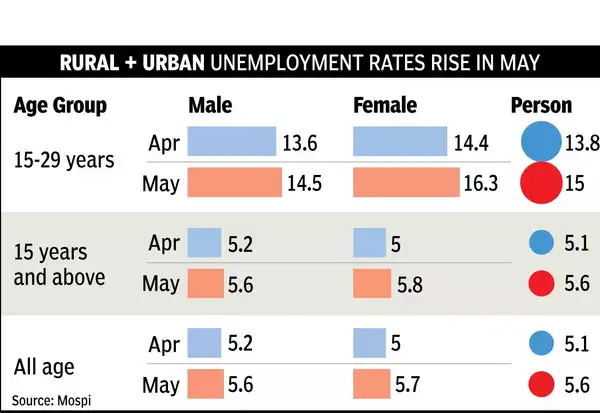Joblessness rate rises to 5.6% in May from 5.1% in April: PLFS

NEW DELHI: The unemployment rate for those in the 15 years and above age group rose to 5.6 per cent in May from 5.1 per cent in April while the labour force participation rate also dipped during the month, indicating some tightness in labour market conditions due to a number of factors, including heatwave conditions in some parts of the country.The Periodic Labour Force Survey (PLFS) monthly data for May showed that in rural plus urban areas, the joblessness rate among males in the 15 years and above age group was at 5.6 per cent, higher than the 5.2 per cent in April. Among females, it was at 5.8 per cent, higher than April’s 5 per cent.The unemployment rate for those in the 15-29 years age group in rural areas among males was at 14 per cent in May, higher than the 13 per cent in April, while among females it was at 13 per cent during the month, higher than the 10.7 per cent in April.

In urban areas, the unemployment rate in the 15-29 years age group was estimated at 15.8 per cent in May, higher than 15 per cent in April, while among females it was at 24.4 per cent in May, above the 23.7 per cent in April.The labour force participation rate (LFPR) in the current weekly status (CWS) among those in the 15 years and above age group was 54.8 per cent during May, compared to 55.6 per cent during April. LFPR in rural areas was 56.9 per cent, and in urban areas, it was 50.4 per cent during May for persons in this age group. LFPR is defined as the percentage of persons in the labour force (working or seeking or available for work) in the population.PLFS has been revamped since January this year, and the latest addition to the jobs data in the form of a monthly bulletin has been done to ensure availability of high-frequency labour market data with robust coverage to aid timely policy intervention. It contains data for both urban and rural areas.The decline in LFPR and worker population ratio (WPR), and the rise in unemployment were driven largely by seasonal agricultural patterns, higher summer temperature in May in some parts of the country, due to which physical outdoor work gets limited and movement of some unpaid helpers to domestic chores, especially in the higher income (top three decile) rural households, the survey results showed.The statistics office said that in rural areas, employment shifted away from the primary sector (agriculture) – from 45.9 per cent in April to 43.5 per cent in May 2025 – to the secondary and services sectors.It said the decline in female LFPR, especially in rural areas (more than one percentage point) was due to fewer women working as casual labourers and unpaid helpers.“Reduction in agricultural activities with the end of the Rabi harvest season for both male and female in the rural areas may have brought about the downward shift in the number of workers,” according to the survey results.




